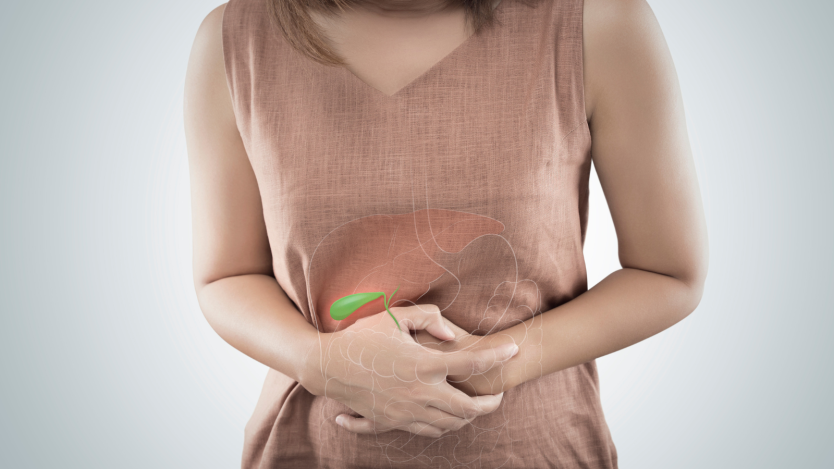Gallbladder polyps, what it is, symptoms and treatment

- What are gallbladder polyps?
- What are the causes of gallbladder polyps?
- What are the symptoms of gallbladder polyps?
- Diagnosis of gallbladder polyps
- Treatment of gallbladder polyps
What are gallbladder polyps?
- Gallbladder polyps are due to elevations in gallbladder mucosa levels.
- Gallbladder polyps can be benign, in most cases, or malignant in a small number of cases.
- The only treatment for gallbladder polyps is cholecystectomy.
The gallbladder is a pear-shaped organ located in the lower region of the liver. Its function is to secrete a substance known as bile, which is generated inside the liver and which causes the fatty components of the food we eat to be digested so that they can be absorbed by the small intestine itself.
Gallbladder polyps are defined as small, well-defined elevations of the gallbladder mucosa. The gallbladder mucosa is the innermost part of the gallbladder wall and therefore most in contact with bile salts.
The frequency of this type of alteration of the gallbladder wall is less than 1% and much less frequent than the presence of gallstones or cholelithiasis, although it is solved by cholecystectomy just like gallstones.

Do you have gallbladder polyps?
Request a free appointment with our specialists in general surgery and get your surgery date
What are the causes of gallbladder polyps?
The causes of gallbladder polyps are not entirely clear and the relationship between certain risk factors and the presence of gallbladder polyps has not been scientifically proven. However, several factors can be identified that should alert the specialist physician to the suspicion of complications in the treatment of gallbladder polyps.
These factors are patient age over 60 years, presence of gallstones and polyp size greater than 6 mm, especially of the solitary and sessile type.

One of the theories that is currently gaining strength, in terms of trying to explain the causes or origin of the presence of polyps in the gallbladder, is the increased risk of polyps in the gallbladder in those patients who have suffered one or more inflammatory processes of the gallbladder such as acute cholecystitis, repeated biliary colic, etc.
The presence of genetic diseases that promote the presence of polyps in different parts of the human body is also suggestive of the presence of polyps inside the gallbladder.
Not all gallbladder polyps are malignant. A classification is currently accepted in order to divide and study the different types of polyps:
- Non-neoplastic gallbladder polyps or pseudopolyps: such as cholesterol polyps, inflammatory gallbladder polyps and hyperplastic gallbladder polyps. These types of polyps are benign and have no malignant potential.
- Neoplastic or true gallbladder polyps: these types of gallbladder polyps can be further divided into:
- Benign: adenoma or adenomatous polyp.
- Malignant: adenocarcinomatous polyp.
Of all the types of polyps, which as mentioned above are mostly benign (95% of them), the most common are cholesterol polyps. This type of polyp in the gallbladder occurs when the lamina propria is infiltrated by lipid-laden foamy macrophages.
Cholesterol polyps account for about 60% of all gallbladder polyps and are usually smaller than 10 mm.
What are the symptoms of gallbladder polyps?
It is generally understood that gallbladder polyps alone do not cause symptoms. In most cases, patients with gallbladder polyps also suffer from gallstones, so in the presence of abdominal symptoms it is very difficult to discern whether gallbladder polyps or gallstones are the cause.
However, in some cases, adenomas or adenomatous polyps in the gallbladder may manifest with abdominal pain in the right hypochondrium (space in the abdomen below the ribs on the right side of the chest) primarily and less frequently as biliary colic or cholecystitis.

Diagnosis of gallbladder polyps
The diagnosis of the vast majority of gallbladder polyps is made accidentally during an imaging test for the study of an abdominal alteration. This exemplifies the difficulty in diagnosing them and the limited clinical repercussions of these entities.
Ultrasonography is the technique of choice to demonstrate gallbladder injury.
The increased use of ultrasound in patients with suspected gallstones has increased the detection rate of gallbladder polyps. It allows for localisation and detection of changes on follow-up.
Despite this, it is difficult to define the nature of gallbladder polyps by this examination, and in the case of polyps with more suspicious characteristics, it is necessary to complement ultrasound by magnetic resonance imaging (MRI) or CT scanning.
Treatment of gallbladder polyps
The definitive treatment to eradicate the existence of polyps in the gallbladder is surgery to remove the entire gallbladder or cholecystectomy.
However, due to the nature of the gallbladder polyps themselves, as we have been discussing, it is usual to carry out annual or biannual monitoring to check the stability of their growth and to ensure that there are no factors that could indicate a malignant process of these polyps.
In any case, in order to determine the management to be performed once a vesicular polyp is detected, it is important to obtain the size. Therefore, in asymptomatic patients with a detected polyp smaller than 10mm, the approach is conservative, with no need for surgical intervention.
On the other hand, if the patient is asymptomatic but the polyp is larger than 10mm, according to the literature, prophylactic surgical management is justified, i.e. complete removal of the gallbladder, as these gallbladder polyps are considered potentially malignant lesions.

Do you need gallbladder surgery to remove polyps?
Request a free and immediate appointment with our specialists in General surgery
Medical disclaimer: All the published content in Operarme is intended to disseminate reliable medical information to the general public, and is reviewed by healthcare professionals. In any case should this information be used to perform a diagnosis, indicate a treatment, or replace the medical assessment of a professional in a face to face consultation. Find more information in the links below:
